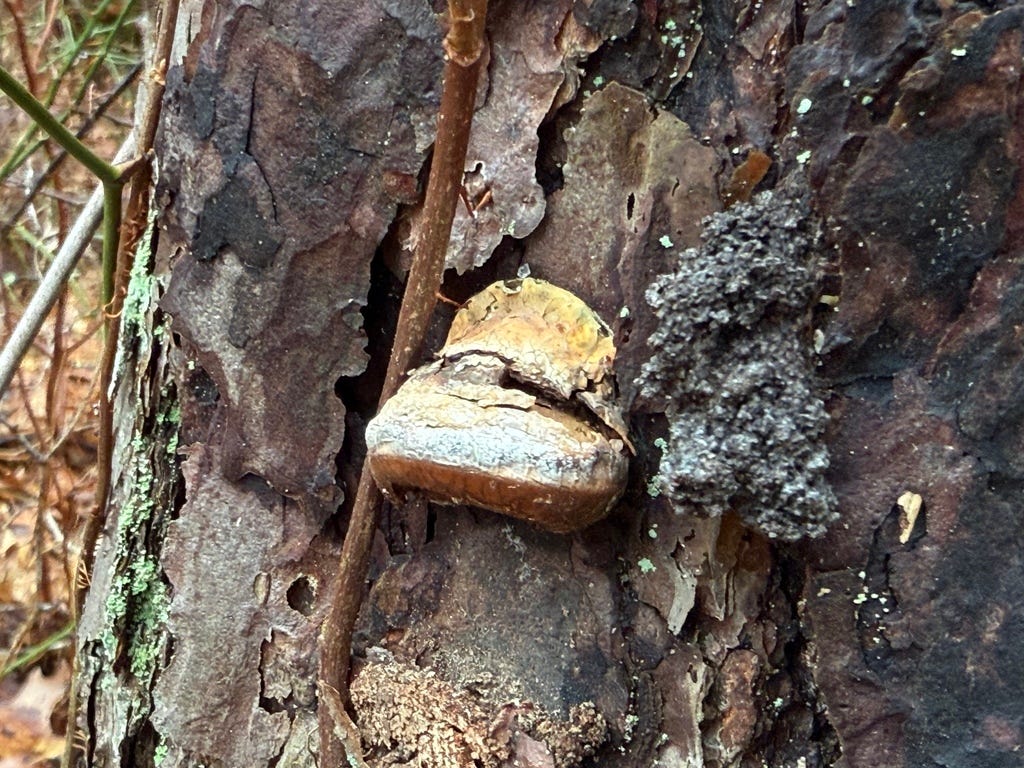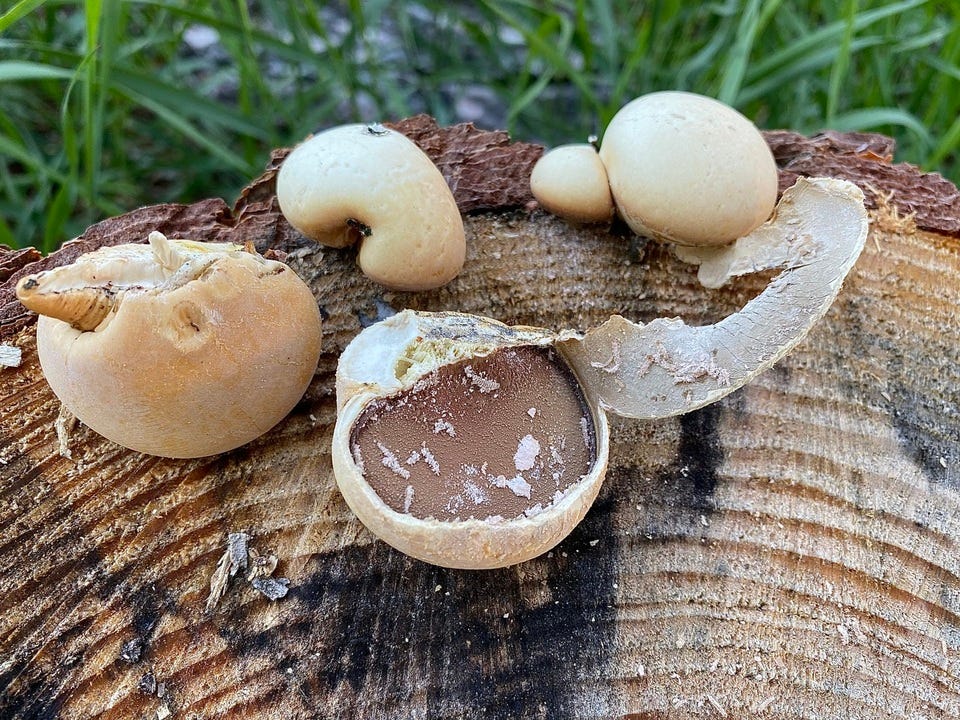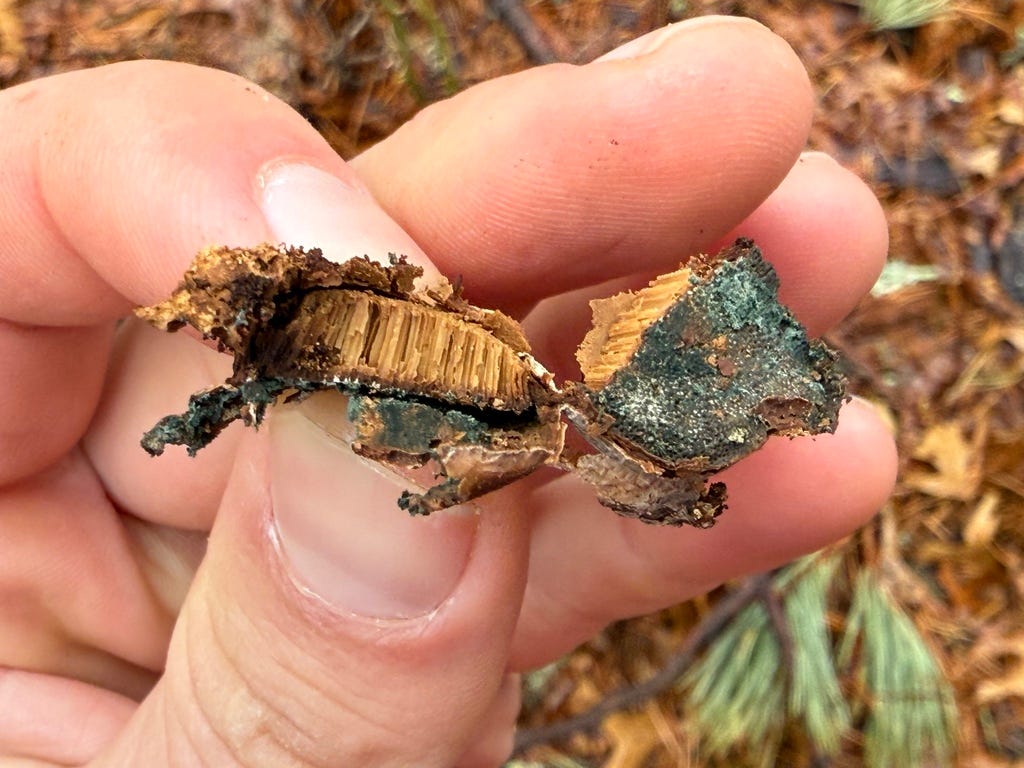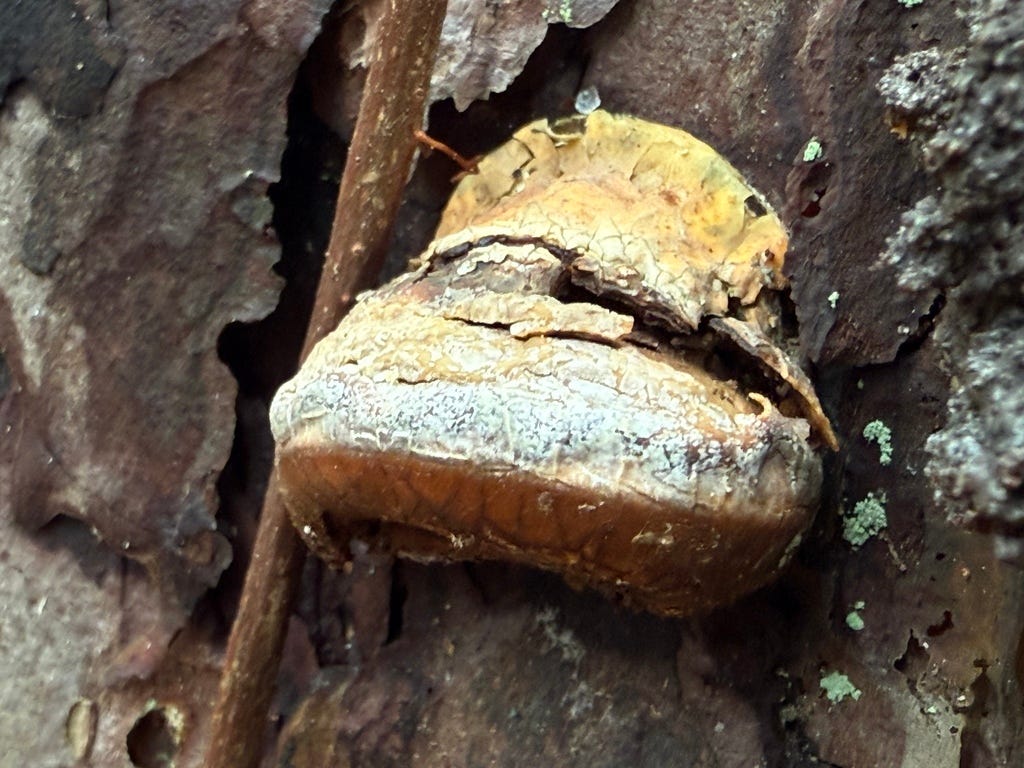Good morning, friends,
This week’s mushroom comes to us from a rainy day a couple weeks ago in Beebe Woods in Falmouth, MA. The nice thing about looking for mushrooms when the woods are wet is that the lighter colors, in this instance the white of the mushroom, really pop amidst the darker browns and grays of a wet winter woodland. There’s a lot to say about this peculiar polypore. It has a unique relationship with insects, a potentially positive impact on humans, and a definitely not so positive impact on pine trees.

Compounds with Potential Benefits
The mushroom is not only chock-full of insects (as we’ll read later) but it also contains a lot of novel compounds that could yield potential human benefits. A study out of Japan found that a water soluble compound (something that could theoretically be extracted just by making a tea) demonstrated antitumor activity (Reference 2).
A 2014 study out of China also found that aqueous extracts (again, tea) of the fungus inhibited H1N1 swine flu both in cells (in vitro) and also in living mice (in vivo). The researchers were interested in the fungus because it has traditionally been used to treat bronchitis and asthma in Traditional Chinese Medicine.
Their findings showed mice that received the extracts were completely immune to the lethal effects of the virus, but interestingly it wasn’t because the extracts reduced the viral titer (the concentration of infectious virus particles). There was some other mechanism, possibly a reduction of inflammation, that prevented the mice from succumbing to H1N1. The researchers were using a crude extract and postulated that there could have been multiple compounds acting together to reduce symptoms in the mice. More research is needed to know for sure.

Etymology
Cryptoporus comes from the Ancient Greek kryptós which means “hidden” and póros which, you guessed it, means “pores”. The name references how the pores are hidden under a membranous sheath (seen above). The species epithet volvatus references this same volva-like structure.
Typically, a volva is the membranous cup that encapsulates an immature cap and stem mushroom, the white flecks on Amanita muscaria are remnants of the volva, but uniquely C. volvatus is the only polypore that possesses this feature.

An Intricate Ecosystem
These small polypores appear on standing, dead conifers — usually trees that were devoured and killed by bark beetles, but sometimes trees that died from other causes (like burns). The exact ecological functioning of the fungus isn’t totally agreed upon and, like most Mushroom Monday endeavors, I commit to hours of research for the reward of being more confused and unsure than when I started.
The general understanding is that a conifer bark beetle (of which there are 6,000 species across the globe) will carry the spores of the fungus on their body while they burrow into a conifer tree. When a bark beetle finds a suitable tree — usually one in decline from other stressors be it drought, infection, etc. — they will release pheromones to attract and mass other bark beetles.
The bark beetles en masse infiltrate the tree and eat the phloem layer (cells the tree uses for nutrient transport) which subsequently kills the tree. This allows the fungus (a decomposer) to begin digesting the fresh, dead wood. There’s even thinking that the fungus could help prevent the tree from fighting off the beetles by choking off its vascular system. The mushrooms tend to grow right out of the beetle bore holes.

A lot of thought has been give to the purpose of the mushroom’s veil which traps the spores as they fall. It is counterintuitive, no? You would think the mushroom would want the spores to fall as far away from the tree as possible. Well, in theory, the mushroom traps its own spores to attract insects into the veil to eat and/or get covered in the spores, and then distribute them wherever the insects fly to next.
If it all was that simple. Alas, the relationship between the mushroom and insects has been long disputed. A study out of Iowa State posited that the mushroom doesn’t rely on insects to disperse spores (Reference 2). While a hole in the veil naturally develops, initially thought to entice insects inside, the researchers posited that this hole was instead used to allow spores to exit the veil. These researchers found an average of 2.5 billion spores escaped from the hole(s) in the veil across the seven mushrooms they sampled - all released into the air without the aid of insects.
They also noted that while there were a lot of insects that would feed in or around the fungus, the bark beetles were not one of them. The authors suggested that the bark beetles would acquire the spores while flying, and that the veil around the mushroom’s way of retaining moisture during dry conditions.

However, there were far too many insects in and around the mushroom for the relationship to be coincidental, and other scientists started looking further at how the insects and mushrooms interacted. As staggering as the spore dispersal numbers, the number of insects that are drawn to the mushroom are just as impressive. A study out of Japan counted 8,990 individual insects (across 17 species) in the 438 mushrooms they observed (Reference 5). That gives us an average of over 20 insects per mushroom. These insects were all coated in tens of thousands of C. volvatus spores.
Naturally, an abundance of insects also attracts animals that feed on insects. A study published in Northwestern Naturalist in 2018 noted that white-headed woodpeckers were observed feeding on the insects in and around the Cryptoporus mushrooms (Reference 6).
My Musings
Safe to say, Cryptoporus volvatus mushrooms are a part of an intricate ecosystem that intertwines trees, insects, fungi, and animals. I don’t think the two veil hypotheses (water retention vs insect dispersal) are mutually exclusive. It seems possible that the veil can both assist in water retention and serve as a lure for insects. Other fungi have their spores transported by insects, and others have developed their own physical attributes to boost water retention, but it is still peculiar that this is the only polypore that dons a veil.
Some things we can measure and understand, some things we can’t, and that’s all alright. To think a beetle found a tasty pine tree, called a bunch of other beetles using airborne chemical signals, those beetles all arrived bearing mushroom spores, drilled into the tree and killed it, mushrooms fruited from bore holes in the tree, they were harvested by Chinese scientists, turned into water extracts, injected into mice, and then prevented the replication of the swine flu virus. That seems like more than enough for us to try and wrap our heads around right now.
April Events
3PM 4/19/2025 - Mushroom Cultivation Workshop at Hyannis Country Gardens in Hyannis, MA.
12 PM 04/25/2025 - Wave Hill Mushroom Cultivation Workshop. Bronx, NY.
04/26/2025 & 04/27/2025 - Morelfest in Gettysburg, PA.
Well that was a doozy of an article. Hopefully someone somewhere learned something. I need to go outside,
Aubrey
References:
Kuo, M. (2023, August). Cryptoporus volvatus. Retrieved from the MushroomExpert.Com Web site: http://www.mushroomexpert.com/cryptoporus_volvatus.html
Kitamura S, Hori T, Kurita K, Takeo K, Hara C, Itoh W, Tabata K, Elgsaeter A, Stokke BT. An antitumor, branched (1-->3)-beta-D-glucan from a water extract of fruiting bodies of Cryptoporus volvatus. Carbohydr Res. 1994 Oct 3;263(1):111-21. doi: 10.1016/0008-6215(94)00156-1. PMID: 7982226.
Release of Airborne Basidiospores from the Pouch Fungus, Cryptoporus volvatus Author(s): T. C. Harrington Source: Mycologia, Vol. 72, No. 5 (Sep. - Oct., 1980), pp. 926-936 Published by: Mycological Society of America Stable URL: http://www.jstor.org/stable/3759735 . Accessed: 04/14/2025
KADOWAKI, K. (2010). Species coexistence patterns in a mycophagous insect community inhabiting the wood-decaying bracket fungus Cryptoporus volvatus (Polyporaceae: Basidiomycota). EJE, 107(1), 89-99. doi: 10.14411/eje.2010.012
David M Watson and David Shaw "Veiled Polypore (Cryptoporus volvatus) as a Foraging Substrate for the White-Headed Woodpecker (Picoides albolarvatus)," Northwestern Naturalist 99(1), 58-62, (1 March 2018). https://doi.org/10.1898/NWN17-06.1
https://mushroomexpert.com/fungionwood/poroid%20fungi/species%20pages/Cryptoporus%20volvatus.htm






Delightful summary of the joys of mycology: "I commit to hours of research for the reward of being more confused and unsure than when I started."!